VietTimes – Một ngày đầu năm 2005, Thomas Vallely, Giám đốc Chương trình Việt Nam tại Đại học Harvard nhận được cuộc điện thoại đặc biệt từ người bạn lâu năm, Thủ tướng Chính phủ Phan Văn Khải: “Tommy, tôi muốn đến thăm Harvard”.
>> Kỳ 1: Những người Mỹ nhiều “duyên nợ” với Việt Nam bắc nhịp cầu hàn gắn
>> Kỳ 2: “Bóng ma” POW/MIA, “cuộc chiến” dai dẳng trong lòng nước Mỹ
>> Kỳ 3: Việt Nam – khởi nguồn một tình bạn lạ kỳ của hai ông John
>> Kỳ 4: Đi Mỹ để học từ “kẻ thù” quá khứ
>> Kỳ 5: "Phòng thí nghiệm" của nhịp cầu Việt - Mỹ
Ông Khải cũng chính là người đóng vai trò chủ chốt trong việc thành lập Chương trình Giảng dạy Kinh tế Fulbright, hay còn gọi là Trường Fulbright tại TP.HCM, một dấu nối quan trọng để xây từng viên gạch hợp tác giữa hai cựu thù trong thời kì khó khăn nhất của quan hệ Việt – Mỹ khi còn cấm vận.
Họ quen biết nhau từ năm 1990 khi ông Khải, với vai trò là người đứng đầu Ủy ban Kế hoạch Nhà nước, tham gia các chuyến tham quan học hỏi mô hình kinh tế Đông Á do Vallely tổ chức.
“Khi đó, ông Khải chuẩn bị có chuyến thăm lịch sử đến Mỹ với tư cách Thủ tướng Việt Nam đầu tiên kể từ khi kết thúc chiến tranh. Ông ấy bảo tôi: "Tommy, tôi muốn đến thăm Harvard, nhờ Harvard giúp chúng tôi xây dựng trường đại học". Vậy là tôi sắp xếp chuyến thăm cho ông ấy”, Vallely nhớ lại.
Khi ấy, người sáng lập Trường Fulbright, Thomas Vallely không thể hình dung chuyến thăm này chính là khởi đầu cho hành trình xây dựng đại học đẳng cấp quốc tế đầu tiên ở Việt Nam, được truyền cảm hứng bởi những giá trị truyền thống của giáo dục khai phóng kiểu Mỹ, khiến ông cùng các cộng sự miệt mài theo đuổi trong suốt hơn một thập niên về sau.
“Từ Tuyệt vọng tới Triển vọng”
Ngày 24/6/2005 là ngày Chủ tịch Đại học Harvard, Giáo sư Lawrence H. Summers đón tiếp một vị khách đặc biệt: Thủ tướng Chính phủ Phan Văn Khải. Chuyến thăm chính thức Hoa Kỳ lần đầu tiên của một nhà lãnh đạo cấp cao Việt Nam kể từ khi hai nước kết thúc chiến tranh và bình thường hóa quan hệ đã thu hút sự chú ý của dư luận quốc tế.
Câu chuyện của Thủ tướng Phan Văn Khải với Chủ tịch Harvard Lawrence H. Summers không chỉ dừng ở Chương trình Giảng dạy Kinh tế Fulbright, một chương trình hợp tác giữa Trường Quản lý Nhà nước Kennedy thuộc Đại học Harvard và Đại học Kinh tế TP. Hồ Chí Minh, nơi đã đào tạo hàng trăm cán bộ quản lý cho các cơ quan chính phủ và địa phương kể từ khi Việt Nam bắt đầu đổi mới kinh tế.
Ông Khải chủ động đề cập một tầm nhìn rộng lớn hơn, đó là đặt vấn đề nhờ Harvard, với kinh nghiệm và uy tín của một trường đại học số một thế giới, sẽ giúp Việt Nam xây dựng một trường đại học đẳng cấp quốc tế ở Việt Nam và dành cho người Việt Nam.
Khi đó, các nhà lãnh đạo đất nước thực sự sốt ruột với những yếu kém, trì trệ của hệ thống giáo dục đại học quốc gia. Nền kinh tế đang tăng trưởng nhanh chóng và trên đà hội nhập quốc tế của Việt Nam đang khát cầu nguồn nhân lực chất lượng cao, nhưng các trường đại học chưa đáp ứng được nhu cầu bức thiết này.
Dù có đến hàng trăm trường đại học, nhưng Việt Nam không có một trường đại học nào có chất lượng được công nhận ở khu vực hay quốc tế.
Mặc dù, đúng như Vallely đã cảnh báo trước, “Harvard sẽ không mở chi nhánh ở nước nào cả vì họ muốn duy trì uy tín”, nhưng ban lãnh đạo Harvard “sẵn sàng tư vấn và hỗ trợ Việt Nam trong việc quản lý giáo dục đại học”, xuất phát từ mối quan hệ hợp tác bền chặt đã được gây dựng từ năm 1994 thông qua Chương trình Giảng dạy Kinh tế Fulbright.
Dưới sự sắp xếp của Thomas Vallely, ông Phan Văn Khải được mời tham dự một buổi thuyết trình mang tên ''Giáo dục Đại học ở Việt Nam: Từ Tuyệt vọng tới Triển vọng'' do Giáo sư Henry Rosovsky, một nhà lãnh đạo giáo dục nổi tiếng từng phụ trách phát triển hệ đại học của Harvard trình bày.
Giáo sư Rosovsky đưa ra một vài gợi ý về cách thức các nước đang phát triển như Việt Nam có thể xây dựng hệ thống giáo dục đại học thành công.
“Ông Khải hỏi Rosovsky: Thế nào là một trường đại học đẳng cấp quốc tế? Rosovsky đã trả lời rằng: Đó là sự kết nối với thế giới. Họ phải biết rõ những gì người khác đang làm trong cùng lĩnh vực của mình, dù là ở Harvard, Stanford hay Thanh Hoa.
Vấn đề của Việt Nam, như Giáo sư Hoàng Tụy từng chỉ ra, là Việt Nam luôn chỉ tự so sánh với chính mình, từ khoa học, y dược đến mọi ngành khác. Muốn trở nên xuất sắc thì anh phải kết nối được và tự so sánh mình với thế giới”, Vallely kể.
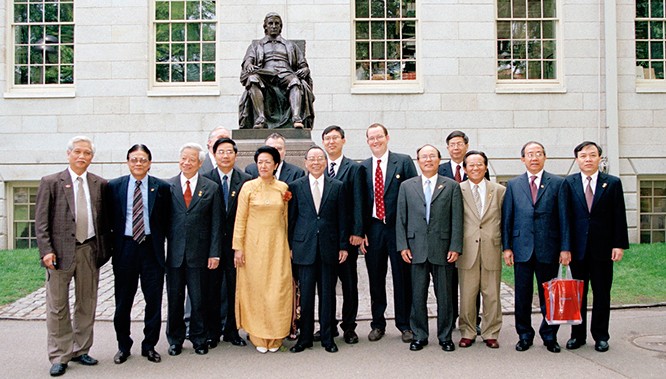 |
Nhóm thành viên Fulbright cùng đoàn đại biểu Việt Nam và Thủ tướng Phan Văn Khải chụp ảnh lưu niệm bên tượng John Harvard (Ảnh: Thomas Vallely cung cấp) |
Sau chuyến thăm, một nhóm đặc trách do Thomas Vallely dẫn đầu đã thực hiện các nghiên cứu, phân tích quan trọng về việc làm thế nào để Việt Nam có thể xây dựng được trường đại học đẳng cấp quốc tế.
Bản báo cáo mang tên “Giáo dục Đại học – Cao đẳng Việt Nam: Khủng hoảng và đối phó” của nhóm tác giả Harvard ra đời năm 2009 không chỉ mô tả chính xác thực trạng yếu kém và tụt hậu ngày càng xa hơn của hệ thống giáo dục đại học Việt Nam so với khu vực, chỉ ra những căn nguyên dẫn tới cuộc khủng hoảng này mà còn đưa ra những đề xuất cải cách táo bạo.
“Nếu không có cải cách khẩn cấp và căn bản đối với hệ thống giáo dục đại học – cao đẳng, Việt Nam sẽ không đạt được đúng mức tiềm năng to lớn của mình”; báo cáo cảnh báo.
Mặc dù cải cách quản lý sâu rộng là chìa khóa cho việc cải thiện giáo dục đại học Việt Nam, nhưng nhóm tác giả cũng thừa nhận rằng “đổi mới các cơ sở giảng dạy ở bất cứ đâu đều là một quá trình lâu dài”.
Bởi vậy, Thomas Vallely và các cộng sự đề xuất rằng “Việt Nam phải xây dựng một cơ sở giáo dục đại học hoàn toàn mới mà ngay từ khi bắt đầu đã phải có được sự quản lý tốt ngay trong gien thể chế của mình. Một nỗ lực như vậy sẽ có tác động mang tính biến đổi đối với giáo dục đại học Việt Nam”.
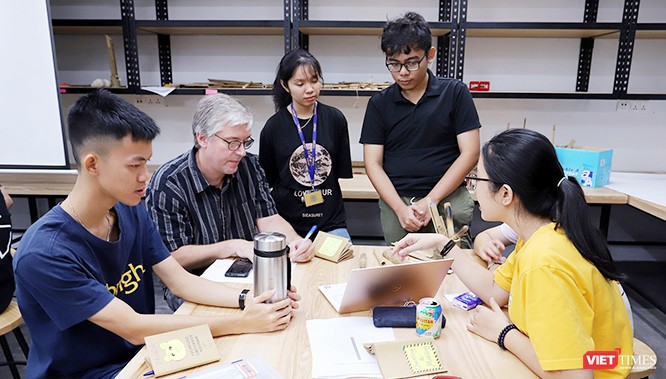 |
Các sinh viên chương trình cử nhân ĐH Fulbright trong lớp học Nhập môn Kỹ thuật (Ảnh: FUV cung cấp cho VietTimes) |
Nói cách khác, cơ sở giáo dục đại học mới này sẽ đóng vai trò như một “cuộc thử nghiệm mô hình quản trị”, với môi trường tự do học thuật và tự chủ về cơ chế quản trị, tương tự như mô hình của các đại học tinh hoa trên thế giới.
“Từ vài văn bản đề xuất đó, lãnh đạo Đảng và Nhà nước Việt Nam đặt vấn đề với chúng tôi: Tại sao các ông không thử làm đi? Chúng tôi đã bắt đầu ý tưởng xây trường đại học đẳng cấp quốc tế theo cách như vậy” - Vallely nhớ lại.
Gần một thập niên “hào hứng lẫn e ngại”
Vào thời điểm mà rất nhiều thứ khác ở Việt Nam đang được nhìn nhận, đánh giá lại, bản đề xuất đó đã đem đến “cả sự hào hứng lẫn e ngại” khi được đặt trên bàn của các nhà lãnh đạo Việt Nam, ông Nguyễn Xuân Thành, Giám đốc Chương trình Giảng dạy Kinh tế Fulbright, một thành viên nòng cốt trong nhóm sáng lập Đại học Fulbright nhận xét.
Giống như Chương trình Giảng dạy Kinh tế Fulbright trước đó, Đại học Fulbright Việt Nam khi ấy có thể xem như một thách thức mới với một hệ thống chủ yếu được xây dựng trên nền tảng những trường đại học công lập hiện có và những cơ sở tư thục vì lợi nhuận, vốn bị trì kéo bởi cơ chế quản lý tập trung hóa cao độ, thiếu trách nhiệm giải trình và động lực cạnh tranh.
Ý tưởng về một cơ sở giáo dục đại học có tự do học thuật và cơ chế quản trị độc lập theo mô hình Mỹ, do đó, được xem là táo bạo trong bối cảnh chính trị - xã hội Việt Nam khi ấy.
Suốt nhiều năm sau đó, bằng các mối quan hệ thân thiết với chính giới ngoại giao hai nước, đặc biệt cùng các bạn bè của ông là Thượng nghị sĩ John Kerry - sau đó là Ngoại trưởng Hoa Kỳ, Thượng nghị sĩ John McCain cùng nhiều cựu binh Mỹ, Thomas Vallely đã nỗ lực vận động để ý tưởng xây dựng một đại học kiểu Mỹ ở Việt Nam chính thức hiện diện trên bàn nghị sự trao đổi giữa hai nước.
Tháng 7/2013 đánh dấu một bước ngoặt trong hành trình theo đuổi giấc mơ xây trường đại học đẳng cấp quốc tế của những người bạn Mỹ – Việt với chuyến thăm chính thức Hoa Kỳ của Chủ tịch nước Trương Tấn Sang.
Trong Tuyên bố chung về Quan hệ Đối tác toàn diện Việt Nam – Hoa Kỳ, Chủ tịch nước Trương Tấn Sang và Tổng thống Barack Obama lần đầu tiên đề cập đến sáng kiến này. Dòng chữ trong Tuyên bố chung ghi rõ: “Chủ tịch nước Trương Tấn Sang và Tổng thống Obama ghi nhận thành công của Chương trình giảng dạy kinh tế Fulbright và Chủ tịch nước Trương Tấn Sang hoan nghênh sáng kiến thành lập trường Đại học Fulbright ở Việt Nam”.
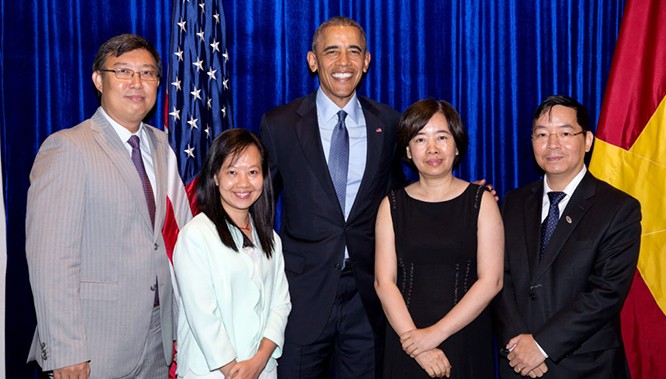 |
Tổng thống Barack Obama cùng các thành viên Việt Nam trong nhóm sáng lập Đại học Fulbright (Ảnh: Nhà Trắng) |
Bên lề chuyến thăm quan trọng này, Thomas Vallely và bạn, cựu Thượng nghị sĩ Bob Kerrey, khi đó là Chủ tịch Đại học New School (trụ sở tại New York), đã tổ chức một bàn tròn thảo luận về chủ đề: Việt Nam cần làm gì để có một đại học độc lập ưu việt, với sự tham dự của Chủ tịch nước Trương Tấn Sang và Bộ trưởng Bộ Giáo dục và Đào tạo Phạm Vũ Luận tại khuôn viên trường New School (New York).
Vào thời điểm đó, New School nổi lên trong giới đại học Mỹ như một cơ sở giáo dục đại học đổi mới với nhiều ý tưởng cải cách sáng tạo, được dẫn dắt bởi ông Bob Kerrey. Ông Bob Kerrey cũng là một cựu binh trong chiến tranh Việt Nam và từng sát cánh cùng John Kerry, John McCain trong các nỗ lực vận động bình thường hóa quan hệ ngoại giao.
Năm 2000, ông Kerrey và ông John Kerry đồng bảo trợ một dự luật thành lập Quỹ Giáo dục Việt Nam (VEF) từ khoản tiền trả nợ công của chính quyền Sài Gòn mà chính phủ Việt Nam kế thừa để cung cấp các học bổng cao học về khoa học và kỹ thuật cho sinh viên Việt Nam.
“Cũng từ đây, lộ trình thành lập Đại học Fulbright Việt Nam đã được hai bên thống nhất” - Thomas Vallely kể.
Tháng 5/2016, tại Trung tâm Hội nghị Quốc gia, Tổng thống Hoa Kỳ Barack Obama chính thức tuyên bố sự ra đời của Đại học Fulbright Việt Nam, “trường đại học độc lập, không vì lợi nhuận đầu tiên của Việt Nam – nơi sẽ mang đến tự do học thuật và cấp học bổng cho những sinh viên có hoàn cảnh khó khăn”.
Ông Obama tin rằng “những người trẻ tuổi xứng đáng được theo học những chương trình đẳng cấp quốc tế ngay tại Việt Nam”.
Sứ mệnh kiến tạo đổi mới
Một nhà ngoại giao Việt Nam từng nhận xét, dự án Đại học Fulbright giống như một lăng kính phản chiếu quan hệ Việt – Mỹ, khi mỗi bước tiến của dự án này luôn gắn liền với những bước tiến trong quan hệ song phương. Sự gia tăng tin cậy chính trị giữa hai nước được xem là nền tảng quan trọng giúp cho ý tưởng về một trường đại học kiểu Mỹ không còn có vẻ đáng sợ như lúc đầu.
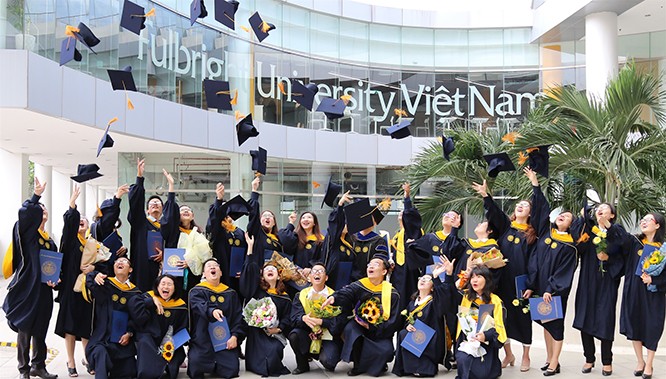 |
Các thạc sĩ chương trình Chính sách Công trong lễ tốt nghiệp (Ảnh: Đại học Fulbright)) |
Cũng giống như sự ra đời của Chương trình Giảng dạy Kinh tế Fulbright hơn hai thập kỉ trước, Đại học Fulbright là kết quả của những thay đổi trong nhận thức và tầm nhìn của các nhà lãnh đạo Việt Nam về sứ mệnh của giáo dục.
“Các nhà lãnh đạo Việt Nam biết rõ những vấn đề của hệ thống giáo dục hiện tại. Họ hiểu rằng, đã đến lúc phải thay đổi nếu không giáo dục sẽ là nút thắt cổ chai đối với sự phát triển kinh tế - xã hội của đất nước” - bà Đàm Bích Thủy, Chủ tịch sáng lập Đại học Fulbright Việt Nam giải thích.
“Bước ra từ một hệ thống nặng về học thuộc lòng, tầm chương trích cú, họ không thể nghĩ và hình thành chính kiến của mình đối với bất kỳ vấn đề nào. Họ có bảng điểm đẹp, nhưng họ không có kỹ năng giải quyết vấn đề khi đối mặt với thực tế công việc” - bà Thủy nhận xét về khả năng phản biện và sáng tạo của các sinh viên tại Việt Nam.
Ông Nguyễn Thiện Nhân (Bí thư Thành ủy TP.HCM, người từng là Bộ trưởng Giáo dục) chia sẻ quan điểm này: “Văn hóa đặt câu hỏi là chìa khóa cho sự đổi mới. Vì thế, Đại học Fulbright được kì vọng như một người tiên phong, kiến tạo những đổi mới trong giáo dục đại học, bắt đầu từ cách tiếp cận của giáo dục khai phóng “dạy sinh viên cách nghĩ, cách học và cách sống”.
Nhưng để hiện thực hóa khát vọng trở thành trường đại học mang tầm ảnh hưởng dẫn dắt ấy, Đại học Fulbright, theo người sáng lập Thomas Vallely, sẽ không thể là “một phiên bản sao chép của Harvard hay bất kỳ trường đại học Mỹ nào khác”.
Vallely tin rằng, cũng giống như cách Đại học Thanh Hoa hơn 100 năm trước được xây dựng từ nguồn tài trợ của Mỹ, nhưng sau cùng đã trở thành trường đại học tinh hoa – tài sản tri thức của Trung Quốc; Fulbright cũng phải “bắt rễ sâu sắc vào xã hội Việt Nam bằng cách đảm bảo rằng chương trình giảng dạy, nghiên cứu của nó đáp ứng được những đòi hỏi của xã hội Việt Nam”.
25 năm trước, Thomas Vallely cùng những người bạn tâm huyết Việt – Mỹ đã cùng nhau xây dựng Chương trình Giảng dạy Kinh tế Fulbright Việt Nam với mục tiêu đào tạo những kiến thức tốt nhất, cập nhật nhất về kinh tế thị trường cho các thế hệ lãnh đạo và quản lý khi Việt Nam mới chập chững đổi mới.
Hơn hai thập kỷ sau, người cựu binh năm xưa lại tiếp tục hành trình mới, xây dựng Đại học Fulbright Việt Nam, nơi kiến tạo những thế hệ có hiểu biết, tầm nhìn và năng lực giải quyết những thách thức của tương lai.
Đã ngoài 70 tuổi, vừa trải qua một cuộc phẫu thuật, nhưng Thomas Vallely vẫn tất bật bay đi bay về giữa hai bờ đại dương.
Ý thức được sự truy đuổi ráo riết của thời gian, song người cựu binh già vẫn lạc quan bởi ông đã tập hợp được một đội ngũ những người Việt tài năng và tâm huyết, những người cùng chia sẻ khát vọng tạo dựng một di sản giáo dục ý nghĩa cho Việt Nam trong tương lai./.
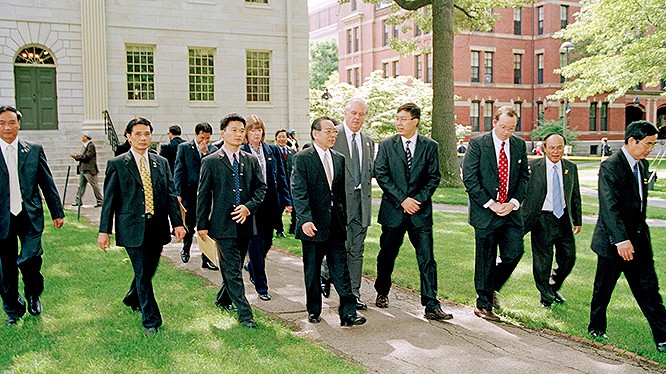
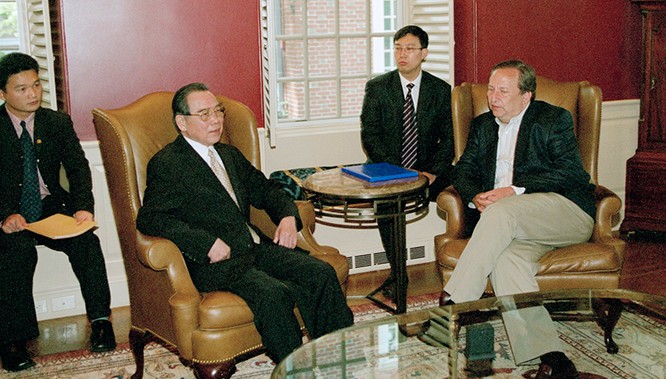
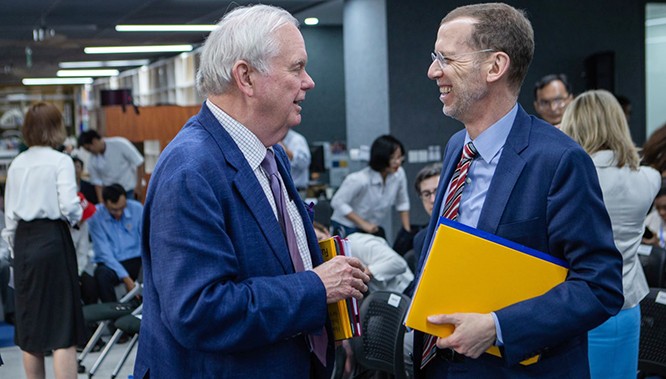





.jpeg)




